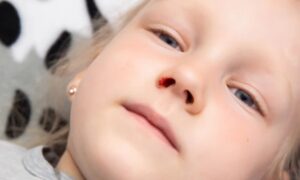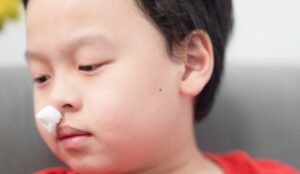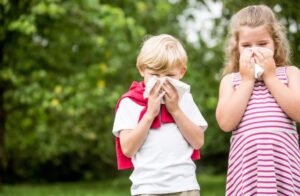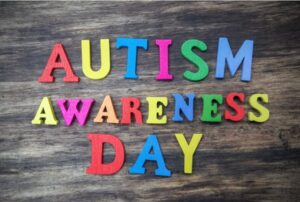Nosebleeds are a common health issue among children. While most cases are not serious, they can cause panic for both kids and parents. Understanding the causes, handling methods, and preventive measures for nosebleeds can help parents respond effectively. This article will explore how to manage nosebleeds in children.
Common Causes of Nosebleeds
Nosebleeds in children can occur for several reasons. Understanding these causes is essential for effective prevention and management:
- Dry Air
Dry air, especially in winter or when using heating systems, can dry out the nasal membranes, leading to bleeding. - Injury
Active children are more prone to nasal injuries from falls, bumps, or frequent nose picking, which can damage the nasal lining. - Allergic Rhinitis
Allergies cause inflammation in the nasal passages, which can weaken blood vessels and result in nosebleeds. - Infections
Upper respiratory infections, such as colds or sinusitis, can inflame the nasal membranes, increasing the risk of bleeding. - Vascular Factors
Some children may have inherently fragile nasal blood vessels, making them more susceptible to nosebleeds.
How to Manage Nosebleeds
If your child experiences a nosebleed, it’s important to stay calm and follow these steps for effective treatment:
- Stay Calm
First, ensure the child sits down and remains calm to avoid increasing heart rate, which can exacerbate the bleeding. - Positioning
Instruct the child to lean slightly forward to prevent blood from flowing down the throat, which can cause choking or vomiting. - Pinch the Nose
Pinch the child’s nostrils together for 5 to 10 minutes. Apply gentle pressure on the lower part of the nose with your thumb and index finger to help stop the bleeding. - Cold Compress
Apply a cold compress or ice pack to the child’s nose and forehead. This can constrict blood vessels and slow the bleeding. - Prevent Dryness
If dry air is the cause of the nosebleed, consider using a humidifier to increase indoor humidity levels. A saline nasal spray can also help to keep the nasal passages moist.
When to Seek Medical Attention
In most cases, nosebleeds are minor and do not require medical attention. However, you should consult a healthcare professional if:
- The bleeding lasts longer than 20 minutes and does not stop.
- There is significant blood loss, and the child feels weak or faint.
- Other symptoms appear, such as fever or swelling around the face.
- The child frequently experiences nosebleeds, which may indicate an underlying health issue.
Preventive Measures for Nosebleeds in Children
To reduce the frequency of nosebleeds, parents can take several preventive steps:
- Maintain Indoor Humidity
Use a humidifier during dry seasons to keep the air moist, preventing the nasal membranes from drying out. - Teach Proper Nasal Hygiene
Educate children to avoid picking their noses, as this can damage the nasal lining and lead to bleeding. - Ensure Proper Nutrition
A balanced diet rich in vitamins C and K can help strengthen blood vessel walls, reducing the risk of nosebleeds. - Regular Check-ups
If your child frequently experiences nosebleeds, it’s advisable to consult a doctor to rule out any underlying health conditions.
Key Takeaways
Nosebleeds are a common occurrence in children, but with the right approach, their frequency can be reduced. Parents should learn how to manage nosebleeds properly and seek medical help when necessary. Maintaining good nasal hygiene, boosting immunity, and providing a healthy diet are key to preventing nosebleeds and promoting overall health.
FAQ
1. How common are nosebleeds in children?
Nosebleeds are common, especially in children aged 5 to 10 years. Most are harmless, but understanding the causes and proper management is essential.
2. What causes nosebleeds in children?
Common causes include dry air, injuries (like nose picking), allergies, infections, and fragile blood vessels in the nose.
3. When should I see a doctor for my child’s nosebleeds?
Seek medical attention if the bleeding lasts longer than 20 minutes, if there’s significant blood loss, or if your child frequently experiences nosebleeds.
4. How can I prevent my child from getting nosebleeds?
Maintain indoor humidity with a humidifier, teach your child not to pick their nose, and ensure a diet rich in vitamins that support blood vessel health.
5. Can I use ointments to treat my child’s nosebleeds?
In most cases, ointments aren’t necessary. Standard methods like pinching the nose or using a cold compress are usually enough. Consult a doctor if nosebleeds persist.
References
- Mayo Clinic. (2023). "Nosebleeds." Retrieved from Mayo Clinic
- American Academy of Otolaryngology. (2023). "Nosebleeds (Epistaxis)." Retrieved from AAO-HNS
- WebMD. (2023). "Nosebleeds: Causes, Symptoms, and Treatments." Retrieved from WebMD
- National Health Service (NHS). (2023). "Nosebleeds." Retrieved from NHS











